Explore Bayankhongor - Mongolia Travel, Asia
Bayankhongor, nestled in the heart of Mongolia, is a destination that promises a blend of natural beauty, cultural richness, and historical intrigue. From the sprawling Gobi Desert to the vibrant local festivals, Bayankhongor offers an off-the-beaten-path adventure for those eager to explore its secrets. Travel through the essence of Bayankhongor, highlighting its history, culture, top attractions, and culinary delights to experience Mongolian nomadic lifestyle.
Population: Approximately 31,000 in 2017.
Economy: The city economy mostly comes from agriculture, as Bayankhongor is the agriculture hub of Mongolia, and tourism.
Landmarks: Famous for Gobi Desert, Tsagaan Agui (or the White Cave), and Shargaljuut Hot Springs.
Mongolia
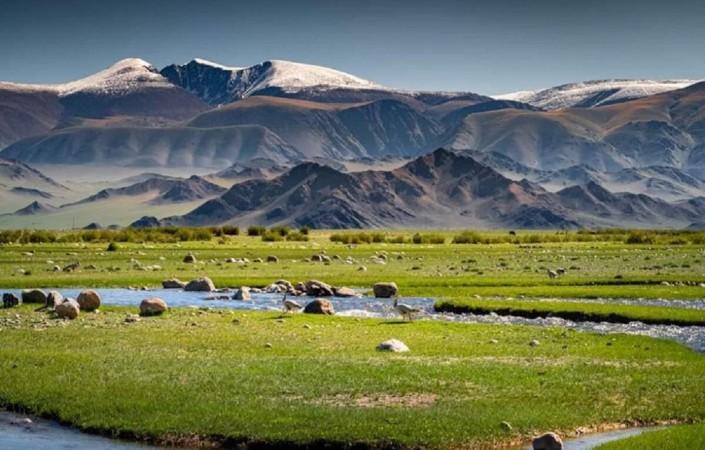
Overview of Bayankhongor
History & Cultural Influence
With strands from historic events and ancient cultures, Bayankhongor presents a complex historical heritage. This region, historically inhabited by nomadic tribes, has preserved its heritage through various archaeological sites and cultural landmarks. In addition, Bayankhongor's cultural influence is also evident in its traditional crafts and rituals. The art of felt-making, for instance, has been passed down through generations, creating intricate designs that reflect the region’s heritage. Visiting local artisans allows travelers to witness this craftsmanship firsthand and even participate in workshops.
Interaction with the Locals
Bayankhongor, a province in central Mongolia, is home to approximately 31,000 residents. The population primarily consists of ethnic Mongolians, many of whom continue to live a traditional nomadic lifestyle. The citizens of Bayankhongor are known for their warm hospitality and strong cultural heritage, often welcoming visitors with traditional customs and local cuisine. This close-knit community values their rich history and the natural beauty of their surroundings, making them an integral part of the region's charm and appeal.
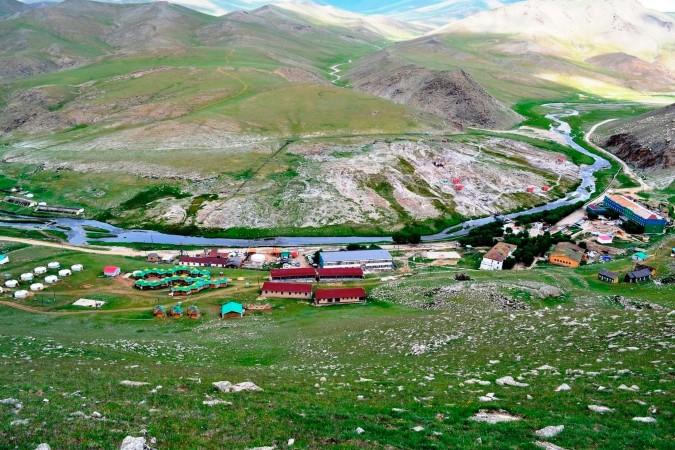
Bayankhongor natural beauty - © Mongolia Tourism
Top Attractions in Bayankhongor
Bayankhongor is a treasure trove of natural and cultural wonders waiting to be explored. These top attractions highlight the diverse appeal of the region, offering visitors a mix of adventure, history, and relaxation. Each site provides a unique glimpse into the region's natural beauty and cultural heritage, ensuring an unforgettable experience for all who visit.
Gobi Desert
One of the most well-known deserts in the world, the Gobi Desert, crosses many provinces, including Bayankhongor. This vast and varied landscape is a haven for adventurers and nature enthusiasts alike. The Gobi has amazing dunes, striking rock formations, and a distinct ecology that is brimming with life. Explore the striking Flaming Cliffs (Bayanzag), which are well-known for their rich deposits of dinosaur fossils, go on camel trekking tours to experience the traditional manner of traveling across the Gobi desert and capture the breathtaking beauty of the never-ending golden dunes.
Tsagaan Agui (White Cave)
Tsagaan Agui, or White Cave, is an archaeological wonder located in the Khar Nuur district of Bayankhongor. This ancient site has provided valuable insights into early human habitation in the region, with artifacts dating back thousands of years. The cave's interior features fascinating stalactite formations and ancient petroglyphs that offer a glimpse into the lives of its prehistoric inhabitants.
Bayankhongor Provincial Museum
The Bayankhongor Provincial Museum is a must-visit for anyone interested in the rich cultural heritage of the region. This museum houses a diverse collection of artifacts, ranging from traditional clothing and tools to ancient relics and fossils. The exhibits provide a comprehensive overview of Bayankhongor's history, culture, and natural history, making it an educational and engaging experience for visitors of all ages.
Shargaljuut Hot Springs
Situated in the scenic valley of Shargaljuut, Shargaljuut Hot Springs is well-known for its healing qualities. The hot springs are rich in minerals and are believed to have healing effects on various ailments, including arthritis, skin conditions, and digestive issues. Visitors can relax in the natural hot pools while enjoying the stunning surrounding landscapes. The area is also perfect for hiking and exploring the serene natural beauty of Bayankhongor.
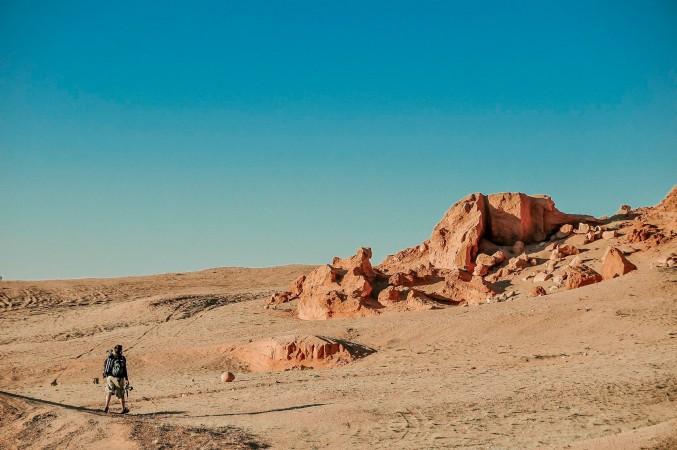
Trekking the Gobi Desert - © Victor He
Must-Try Dishes in Bayankhongor
The delicious food of Bayankhongor is a lovely representation of the nomadic lifestyle and culture of Mongolia. Whether you're sampling traditional dairy products or savoring hearty meat dishes, Bayankhongor's cuisine is sure to leave a lasting impression.
- Boodog: Boodog is a traditional Mongolian dish where goat or marmot is cooked using hot stones placed inside the animal's body. This unique cooking method, combined with the meat’s natural flavors, creates a rich and savory dish that is often served during special occasions and festivals.
- Airag: Airag, also known as kumis, is a traditional Mongolian beverage made from fermented mare’s milk. It tastes slightly sour and has a low alcohol content. Airag is a staple during summer months and is often offered to guests as a sign of hospitality.
- Khuushuur: Khuushuur are fried dumplings filled with minced meat, typically beef or mutton, mixed with onions and spices. These dumplings have a crispy exterior with a juicy, flavorful filling, making it a favorite among locals and tourists alike.
- Tsuivan: Tsuivan is a traditional noodle dish featuring stir-fried noodles mixed with vegetables and meat, usually beef or mutton. The dish is seasoned with salt and occasionally soy sauce, giving it a simple yet hearty flavor. Tsuivan is a comforting and filling meal, perfect for colder days.
- Aaruul: Aaruul, or dried curds, are a traditional Mongolian snack made from fermented milk. It has a hard, cheese-like texture and a tart flavor. Aaruul is often enjoyed with tea and is a staple food for nomadic families due to its long shelf life and nutritional value.
- Khorkhog: Khorkhog is another traditional Mongolian dish where meat (usually mutton or goat) and vegetables are cooked using hot stones. To cook the meal from the inside out, hot stones are added to a metal container containing the ingredients. The result is tender meat with a unique, smoky flavor.

Tsuivan - © TasteAtlas
Festivals & Local Celebrations
Bayankhongor is a region steeped in tradition, and its festivals offer a vibrant glimpse into local culture and customs. These events are not only a time for celebration but also an opportunity for visitors to immerse themselves in the rich cultural heritage of the area.
Naadam Festival
The Naadam Festival, celebrated nationwide, is Mongolia's most significant cultural event, and Bayankhongor hosts its own unique version. Held in July every year, this event features the "Three Manly Games"—archery, horse racing, and wrestling. The event is a spectacle of athletic prowess, traditional costumes, and community spirit. Visitors can enjoy watching the competitions, tasting local delicacies, and participating in the festive atmosphere.
Tsagaan Sar (Lunar New Year)
Tsagaan Sar, or Lunar New Year, marks the beginning of the Mongolian lunar calendar and is a time for family reunions, traditional rituals, and feasting. In Bayankhongor, this festival is celebrated with the preparation of special dishes like Buuz (steamed dumplings) and the exchange of gifts. Travelers visiting during Tsagaan Sar can experience the warmth of Mongolian hospitality and the significance of this cultural tradition.
Shargaljuut Hot Springs Festival
An occasion honoring the healing qualities of Bayankhongor's hot springs is the Shargaljuut Hot Springs Festival. The festival features traditional music, dance performances, and opportunities to relax in the hot springs' mineral-rich waters. It's an excellent chance for visitors to enjoy cultural performances while indulging in the natural spa experience.
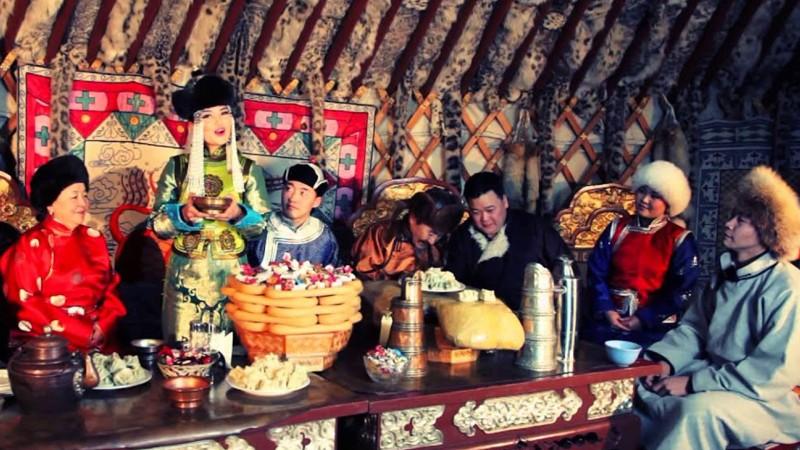
Tsagaan Sar - © CafeF
What to Do in Bayankhongor
- Trekking and Hiking: Explore Bayankhongor’s diverse landscapes, including the Gobi Desert and Khangai Mountains. Enjoy scenic trails to landmarks like White Cave and the serene valleys around Shargaljuut, offering breathtaking views and a chance to connect with nature.
- Wildlife Watching: Discover the region's rich biodiversity, including rare species such as Mongolian gazelles, snow leopards, and various bird species. Join guided tours to observe these animals in their natural habitats, providing an unforgettable wildlife experience.
- Nomadic Cultural Experiences: Immerse yourself in Mongolian nomadic traditions by staying in a traditional ger (yurt) and participating in daily activities such as herding, milking livestock, and crafting. Gain insight into the nomadic lifestyle that has shaped Bayankhongor for centuries.
- Hot Springs and Wellness Retreat: Visit the Shargaljuut Hot Springs, renowned for their therapeutic properties. Enjoy a relaxing soak in the mineral-rich waters, believed to benefit various health conditions, making it a popular destination for rejuvenation and wellness.
Shopping in Bayankhongor
- Local Markets: Visit bustling local markets where you can find fresh produce, traditional clothing, and unique souvenirs. Discover handmade felt products, wool garments, and traditional Mongolian boots, offering a genuine shopping experience.
- Traditional Crafts: Shop for traditional crafts, particularly felt-making and leatherwork. Purchase beautiful items like felt rugs, hats, and decorative pieces directly from local artisans, ensuring an authentic piece of Bayankhongor’s cultural heritage.
- Souvenirs and Specialty Products: Explore specialty products such as traditional dairy items (like Aaruul) and locally produced woolen goods. These unique and meaningful gifts are perfect for taking home a piece of Bayankhongor’s culture and craftsmanship.
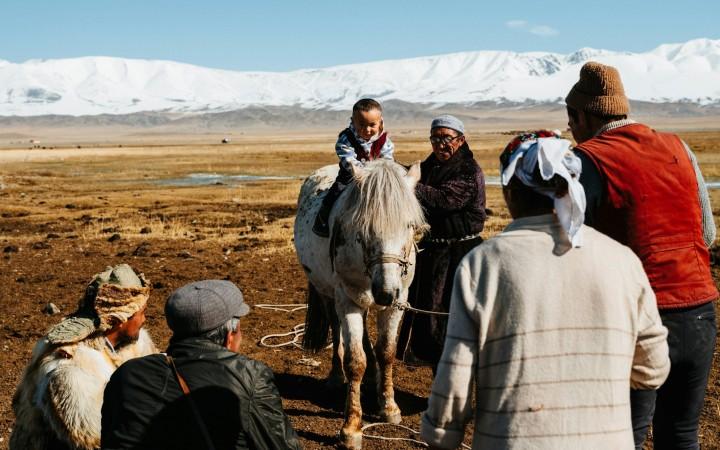
Nomadic Cultural Experience with the local - © Fadhil Abhimantra
Weather in Bayankhongor: Best Time to Visit
Understanding the weather in Bayankhongor is crucial for planning your visit and enjoying all the region has to offer. The province experiences a continental climate with distinct seasons that influence tourism trends throughout the year.
Spring in Bayankhongor
Spring brings gradual warming, with nature coming alive as wildflowers bloom and greenery returns. This season is popular for outdoor activities like hiking and wildlife spotting, as well as for attending local festivals. Spring’s milder temperatures and beautiful landscapes make it an attractive time for travelers who enjoy exploring nature with fewer crowds.
Summer in Bayankhongor
Summer is the peak tourist season in Bayankhongor. The warm temperatures and extended daylight hours are perfect for outdoor adventures, including trekking, wildlife watching, and participating in festivals such as Naadam. However, this is also the busiest time, so advanced bookings for accommodations and tours are recommended to secure your spot.
Autumn in Bayankhongor
Autumn offers cooler temperatures and stunning fall foliage. This quieter season is excellent for sightseeing and enjoying the region’s natural beauty without the summer crowds. Travelers can take advantage of the comfortable weather for exploring and experiencing local life, making it a favorable time for those looking for a more serene visit.
Winter in Bayankhongor
Winters in Bayankhongor are harsh, with temperatures often plunging below freezing and frequent snowfall. This period is ideal for experiencing traditional winter activities and festivals. Visitors seeking a true taste of Mongolian winter can enjoy activities like snow trekking and winter cultural events, though it's essential to prepare for the cold with proper warm clothing.
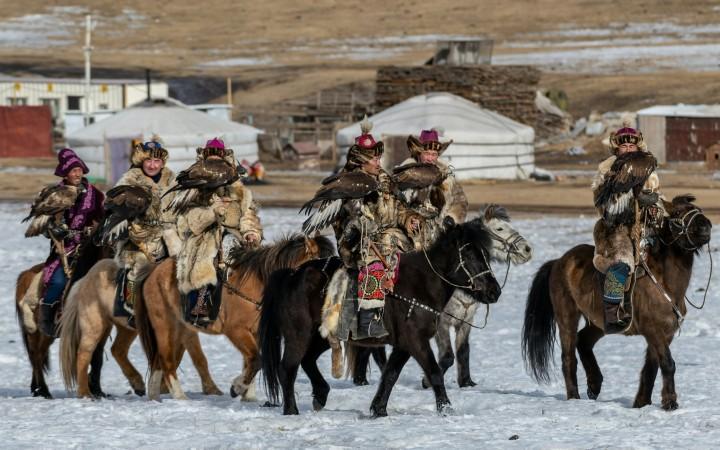
Winter in Bayankhongor - © Khosbayar Surenkhorloo
Culture Etiquette in Bayankhongor
- Respect for Traditions: Mongolians hold their traditions and cultural practices in high regard. Always approach local customs with respect, especially during festivals and ceremonies. Participating respectfully in traditional rituals can enhance your cultural experience.
- Greetings: A common greeting in Mongolia is a nod or a slight bow of the head. Handshakes are also common, but they should be gentle. When addressing elders or those in authority, it’s polite to use formal titles.
- Dress Code: Dress cautiously and modestly when attending local rituals or visiting places of worship. Traditional Mongolian clothing, such as the "deel," is often worn during special occasions, and showing an appreciation for these customs can be seen as a sign of respect.
- Photography: Always ask for permission before photographing people, particularly in rural areas or during ceremonies. Some locals may be uncomfortable with being photographed, and respecting their wishes is important.
- Gifts and Hospitality: If invited into a local's home, it is customary to bring a small gift as a token of appreciation. Common gifts include food items or souvenirs. Using both hands to accept and offer something is considered courteous and respectable.
Essential Travel Information
Getting Around Bayankhongor
Navigating Bayankhongor involves a mix of traditional and modern transportation options, each offering a unique experience:
- Local Buses and Minivans: Public buses and minivans are common for traveling within Bayankhongor and between towns. They are budget-friendly and provide a local travel experience.
- Private Vehicles: Renting a private vehicle or hiring a taxi is a convenient option for exploring the province at your own pace. This allows for greater flexibility and comfort, especially when traveling to remote areas.
- Horseback Riding Tours: For a truly authentic Mongolian experience, consider horseback riding. It’s a traditional mode of transport in rural areas and provides a unique way to explore the landscapes and interact with local herders.
- Domestic Flights: For faster travel between Bayankhongor and other major cities, domestic flights are available. They are a time-efficient way to cover long distances but may require advance booking.
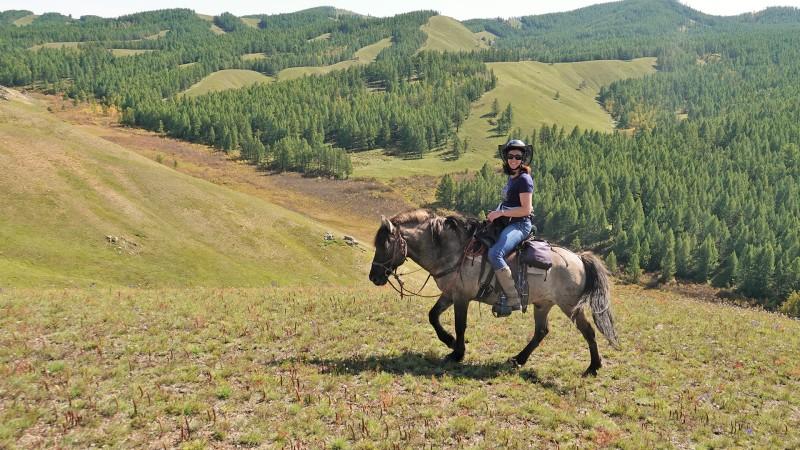
Horseback Riding Tours - © Wild Women
ATM & Banking Services
Bayankhongor provides essential banking services for travelers, including several ATMs mainly in urban areas like the provincial capital, offering convenient cash access. It's wise to carry some cash, particularly when venturing into rural regions where ATMs may be limited. Banking services, such as currency exchange, deposits, and withdrawals, are available locally, and international credit and debit cards are accepted in larger establishments. Comparing rates at different exchange points, such as banks and some hotels, can be beneficial.
Where to Stay in Bayankhongor
A wide variety of lodging choices are available in Bayankhongor to accommodate different tastes and price ranges. In the provincial capital, visitors can choose from a selection of hotels that provide a range of comforts, from budget to mid-range. For a more personal touch, guesthouses offer a cozy atmosphere and opportunities to connect with local hosts, often at a more affordable rate. Experience traditional Mongolian hospitality by staying in a ger camp, where comfortable yurts with modern amenities provide an immersive natural experience.
Articles for you

Explore Yala National Park - Sri Lanka Travel, Asia
Tucked away in Sri Lanka’s southeastern corner, Yala National Park is where wild nature meets deep tradition. Known worldwide for its leopard population, the park is also home to elephants, sloth bears, crocodiles, and hundreds of bird species. Beyond wildlife, Yala opens doors to a cultural landscape dotted with ancient temples, Buddhist ruins, and coastal villages. For travelers seeking more than just a safari, Yala offers a chance to explore eco-tourism, local communities, and sacred heritage sites.
Population: The Yala National Park area doesn’t have a human population.
Economy: The economy around Yala National Park thrives on a blend of eco-tourism, agriculture, and local services. Safari tours, eco-lodges, and cultural experiences drive steady income for nearby towns like Tissamaharama and Kataragama, supporting thousands of families.
Landmarks: Famous for Block I of Yala and wildlife encounters, including elephants, sloth bears, crocodiles, and exotic bird species.

Explore Galle - Sri Lanka Travel, Asia
Nestled on Sri Lanka’s southern coastline, Galle is a vibrant city where history meets the sea. Its cobbled streets, colonial architecture, and serene beaches make it a must-visit destination for travelers seeking a blend of culture, adventure, and relaxation. A UNESCO World Heritage site, Galle captivates visitors with its Dutch Fort, bustling markets, and friendly locals. Whether you’re exploring the ramparts at sunset or savoring fresh seafood by the shore, Galle promises an unforgettable journey into Sri Lanka’s heritage.
Population: Approximately 113,000 in 2023.
Economy: Galle’s economy thrives on tourism, trade, and fisheries. The city’s historic fort, colonial architecture, and coastal charm draw thousands of international visitors each year, making tourism its main economic driver. Fishing remains vital for local livelihoods, supplying fresh seafood across the region.
Landmarks: Famous for the Galle Fort, Dutch Reformed Church & Maritime Museum, and Unawatuna Beach.

Explore Bentota - Sri Lanka Travel, Asia
Nestled along Sri Lanka’s southwestern coast, Bentota is a tropical paradise that blends golden beaches, vibrant culture, and thrilling adventures. Famous for its calm waters, luxury resorts, and scenic river estuary, Bentota has become a top destination for travelers seeking both relaxation and authentic experiences. From serene beach walks at sunrise to adrenaline-pumping water sports, this coastal town offers a perfect balance of leisure and exploration. With its proximity to Colombo and Galle, Bentota is easy to reach, making it an ideal stop for both short escapes and extended holidays.
Population: Approximately 37,000 in 2023.
Economy: Bentota’s economy thrives mainly on tourism, which drives local businesses such as hotels, restaurants, and wellness retreats. The town also benefits from fishing, coconut cultivation, and handicrafts like wood carving and batik textiles. Many residents rely on the growing demand for water sports and Ayurvedic treatments, making tourism the backbone of both income and employment in the area.
Landmarks: Famous for Bentota Beach, Bentota River Safari, and Kande Vihara Temple.

Explore Mirissa - Sri Lanka Travel, Asia
Mirissa is a charming coastal town on Sri Lanka’s southern shoreline. Known for its golden beaches, turquoise waters, and vibrant marine life, it has become a must-visit stop for travelers exploring the island. Many come for whale watching, surfing, and sunset views at Coconut Tree Hill, but Mirissa offers much more than postcard beauty. The fishing boats you see anchored by the bay carry generations of stories. Local traditions, delicious cuisine, and a laid-back rhythm of life shape every visitor’s experience.
Population: Approximately 4,700 in 2023.
Economy: Mirissa’s economy is largely shaped by its coastal location. Fishing has long been the backbone of local livelihoods, with generations relying on the Indian Ocean for income. In recent decades, tourism has become the main driver of growth, thanks to whale watching, surfing, and beachside hospitality.
Landmarks: Famous for Mirissa Beach, Coconut Tree Hill, and Parrot Rock Bridge.

Explore Nuwara Eliya - Sri Lanka Travel, Asia
Tucked away in the Central Highlands of Sri Lanka, Nuwara Eliya is often called “Little England”. With its rolling tea plantations, cool misty mornings, and colonial charm, this mountain town feels like a step into another world. Travelers come here to breathe fresh air, walk through flower gardens, sip the finest Ceylon Tea, and enjoy a pace of life far from the island’s busy cities. Whether you’re drawn by scenic landscapes, heritage architecture, or the warmth of its people, Nuwara Eliya is a destination that blends nature, culture, and history in perfect harmony.
Population: Approximately 781,000 in 2023.
Economy: Nuwara Eliya’s economy thrives mainly on tea production, as it sits in the heart of Sri Lanka’s central highlands, famous worldwide for Ceylon Tea. The city also benefits from a growing tourism industry, attracting visitors with its colonial charm, cool climate, and scenic landscapes.
Landmarks: Famous for Gregory Lake, Hakgala Botanical Garden, and Victoria Park.

Explore Sukau - Malaysia Travel, Asia
Nestled on the banks of the Kinabatangan River in Sabah, Malaysian Borneo, Sukau is a destination where wildlife, culture, and conservation come together. Known as one of Asia’s top spots for river safaris and eco-tourism, this quiet village offers a front-row seat to encounters with Bornean orangutans, pygmy elephants, proboscis monkeys, and exotic birdlife.
Population: Approximately 1,400 in 2019.
Economy: Sukau’s economy is shaped by its riverine location and natural resources. Traditionally, the Orang Sungai community relied on fishing, small-scale farming, and forest gathering for their livelihood. Today, the village has shifted toward eco-tourism, with river cruises, jungle trekking, and homestays providing income.
Landmarks: Famous for the Kinabatangan River cruises, Gomantong Caves, and Ox-bow lakes and wetlands.
